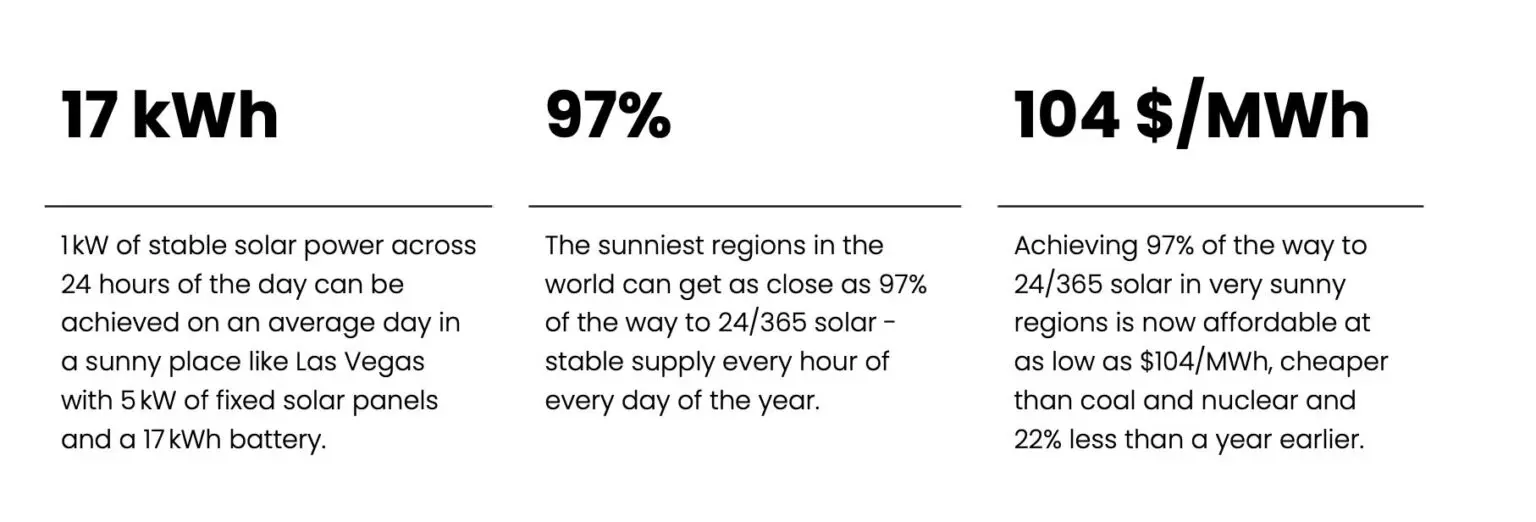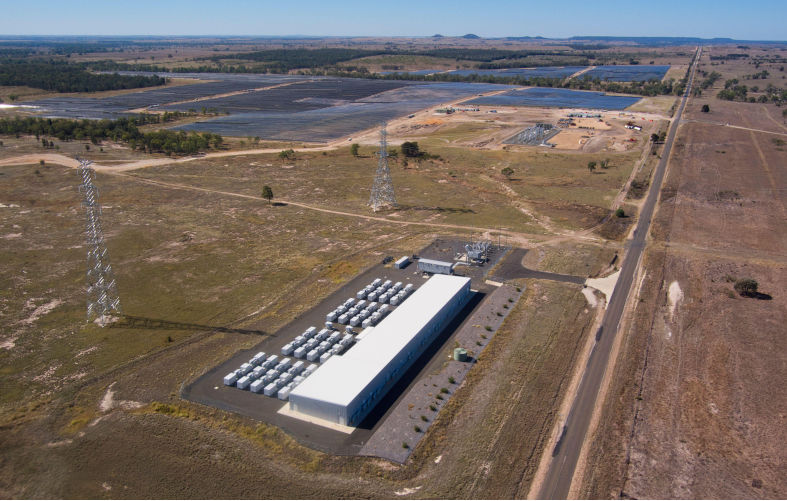'It changes everything': Plunging costs of PV and batteries mean 24-hour solar a growing reality
June 25, 2025
The plunging cost of solar PV and battery storage has opened up a new frontier in the transition to green energy, according to a new report, with cities and industries around the world now able to access low-cost, 24-hour solar generation.
According to the UK-based energy think tank Ember, the combined cost of solar and battery storage has fallen 22% in the last year alone (see graph below).
“This is a turning point in the clean energy transition,” says lead analyst Kostansta Rangelova. “Around-the-clock solar is no longer just a technical possibility and distant dream, but an economic reality.
“It unlocks game-changing opportunities for energy-hungry industries like data centres and manufacturing. Solar will be unleashed. The change is new – the costs and quality of grid batteries have improved so much in the last 12 months. Now it’s time for policy and investment to catch up.”

The concept is not entirely new. Some of the leading investors, such as the Australian-based Quinbrook Infrastructure Partners, have already identified the combination of solar and battery storage as a winner, particularly for large energy users in Australia.
“This is the ‘dam busting’ moment for this country’s decarbonisation,” said Quinbrook co-found David Scaysbrook in March when he announced plans to build 3 GW of solar and 24 GWh of battery storage.
“Solar teamed with battery storage is the engine room of the energy transition. It is the anchor technology combination to deliver low cost power.”
You can hear Scaysbrook discuss the issue in this episode of Renew Economy’s weekly Energy Insiders podcast: Energy Insiders Podcast: The tipping point in solar and battery storage.
Some large energy users are already getting on board. Rio Tinto, which owns the aluminium smelters and refineries in Gladstone, the biggest energy consumers in Queensland, has signed on to a world-leading solar and battery deal as part of its suite of renewable technologies to wean its assets off coal by the end of the year.
Ember makes it clear in its report that it is not suggesting that solar and battery storage will be the only technologies needed on a grid-wide basis. Wind and other firming technologies will also play a critical part, but for individual customers, and even cities, the option for low-cost, zero emissions power contracts is very real.
“The emergence of 24-hour solar generation marks a fundamental shift in how solar fits into the broader power system,” Rangelova says.
“With the ability to deliver electricity around-the-clock, solar can now support 24/7 clean energy contracts (PPAs) for industries which require continuous power, not just daytime supply.
“This is extremely valuable for emerging economies, where solar-powered industrial and economic zones can emerge in sunny areas far from existing grid infrastructure.
“At the same time, it can also bring substantial potential savings on grid expansion costs – allowing up to five times as much solar capacity to be installed behind the same grid connection, maximising existing assets and deferring costly upgrades.”
Ember makes three key observations about the potential for solar and battery storage. The first, which applies to smaller facilities, highlights the scale that battery storage can expand solar output in sundry regions, such as Las Vegas in the example provided.

This means that the sunniest regions can get as close to 97% of the way to 24/365 solar – an extraordinary result, if you think about it. The rest will come from other technologies, depending on the resources available. And it says this is relatively low-cost, and cheaper than either coal or nuclear.
“The opportunity may be even greater for electricity users than for the electricity system itself,” Ember says.
Bigger consumers, like data centres, factories and remote infrastructure, require stable, uninterrupted power. For them, 24-hour solar generation can provide a clean, cost-effective alternative to fossil-based grids – available not just as a future ambition, but as a practical solution today.
“Depending on grid electricity costs, these users can access cheaper solar power through a range of setups — from partial to near-full coverage, using onsite solar with batteries, or through PPAs with solar-plus-storage systems, especially where land is limited.
“In the case of PPAs, matching the supply with the consumer’s hourly demand level can also bring financial benefits by reducing their exposure to volatile spot market prices.”
Of course, in Australia, this reality is already abundantly clear, particularly with households hit by the most extraordinary price spikes in recent weeks, despite the moderation in wholesale electricity markets over the past year.
The regulation of Australia’s retail prices now appears to be in total collapse, with retailers now pushing their market offers up to the assumed market price cap, or default market offer. Some are even pushing their prices above that. One Renew Economy reader advises that his rates have been lifted above the retail market offer.
Ember says that industrial customers, including data centres, are discovering the benefits of solar and battery storage, even in less sunny regions.
“When solar is built with batteries, it becomes possible to align its generation with electricity demand. It is also worth noting that solar with batteries does not need to deliver the same power every single hour of every day to bring major benefits,” it says.
“Even in less sunny regions battery storage can bring more solar electricity across all hours – meaning fewer power plants and grid infrastructure are needed compared to building solar without batteries.”
Ember says battery technology is advancing at “lightning speed”, with prices falling by 40% in 2024 alone, hitting a record low of US$165 per kWh for a full battery system (excluding Engineering, Procurement and Construction and grid connection costs).
It says early 2025 data suggests that the trend is continuing, with two auction results in Saudi Arabia showing prices as low as US$72KWh. “As production scales and efficiency improves, prices are expected to fall even further,” it says.
Ember notes that the first gigawatt-scale 24-hour solar project is also already under development in the UAE, where a Masdar-led project announced in January this year would consist of a 5.2 GW PV plant coupled with a 19 GWh battery storage to provide 1 GW uninterrupted electricity supply to the grid.
In Australia, nearly every new solar project is being built with an accompanying big battery, and some of the duration periods are extending to eight hours, depending on customer demand.
The first solar and battery hybrid, with DC-coupled storage, has begun operations at Cunderdin in Western Australia, and is soaking up excess solar in the middle of the day and injecting it into the grid in the evening peak.
Such systems can be adapted to suit a customer’s needs, and supply constant output if needed, even over a 24-hour period.

So where can this occur? As mentioned above, Ember uses Las Vegas as an example of where the combination of solar and storage can deliver 97% reliability. The table illustrates that many other cities and regions can also access very high shares of solar and battery storage.
“Even Birmingham in the United Kingdom reached 62% of the way to 24/365 solar generation,” it says.
“While it is not imaginable for solar and batteries alone to power users in this city independently, it is high enough to play a substantive role in local generation alongside wind and other electricity sources.”
You can find Ember’s full report here.
Republished from Renew Economy, 24 June 2025
The views expressed in this article may or may not reflect those of Pearls and Irritations.
